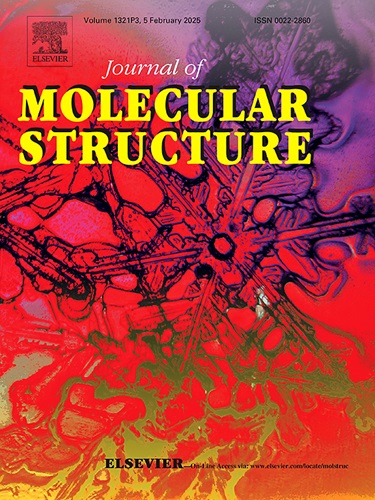Design, structural analysis, and biological evaluation of four mononuclear copper(II) complexes as potent urease inhibitors: Insights from experimental and theoretical studies
IF 4
2区 化学
Q2 CHEMISTRY, PHYSICAL
引用次数: 0
Abstract
This study develops four copper(II)-based coordination complexes (C1-C4) as potential urease inhibitors through rational ligand design. By combining fluorinated Schiff base ligands with modified bipyridine auxiliary ligands, we systematically investigated how electronic and steric factors influence urease enzyme inhibition. The complexes were synthesized and comprehensively characterized including crystallographic analysis, In each of the four complexes, the central Cu(II) exhibits a five-coordinate geometry, incorporating ONO atoms from the Schiff base ligand and two nitrogen atoms from the auxiliary ligand, which results in a distorted square pyramidal configuration. The biological evaluation identified the complex C1 as exhibiting significantly improved urease inhibitory activity, with an IC50 value of 8.88 ± 1.15 μM, in comparison to the standard reference acetohydroxamic acid, which has an IC50 value of 27.73 ± 2.93 μM. Computational approaches complemented experimental studies to decipher the molecular basis of activity differences among the complexes. On this basis, the structural activity relationship study shows that the urease inhibitory activity of complexes is influenced by electron effect and steric hindrance, providing essential insights for developing new urease inhibitors and advancing their biomedical applications.

四种单核铜(II)配合物作为有效脲酶抑制剂的设计、结构分析和生物学评价:来自实验和理论研究的见解
本研究通过合理的配体设计,开发了四种铜(II)基配合物(C1-C4)作为潜在的脲酶抑制剂。通过氟化希夫碱配体与修饰联吡啶辅助配体的结合,系统地研究了电子和空间因素对脲酶抑制的影响。在四个配合物中,每个配合物的中心Cu(II)都呈现五坐标几何结构,包含来自希夫碱配体的ONO原子和来自辅助配体的两个氮原子,从而形成扭曲的方形金字塔构型。生物评价表明,配合物C1具有显著提高的脲酶抑制活性,IC50值为8.88±1.15 μM,而标准参比物乙氧肟酸的IC50值为27.73±2.93 μM。计算方法补充了实验研究,以破译复合物之间活性差异的分子基础。在此基础上,结构活性关系研究表明,配合物的脲酶抑制活性受到电子效应和位阻的影响,为开发新的脲酶抑制剂和推进其生物医学应用提供了重要的见解。
本文章由计算机程序翻译,如有差异,请以英文原文为准。
求助全文
约1分钟内获得全文
求助全文
来源期刊

Journal of Molecular Structure
化学-物理化学
CiteScore
7.10
自引率
15.80%
发文量
2384
审稿时长
45 days
期刊介绍:
The Journal of Molecular Structure is dedicated to the publication of full-length articles and review papers, providing important new structural information on all types of chemical species including:
• Stable and unstable molecules in all types of environments (vapour, molecular beam, liquid, solution, liquid crystal, solid state, matrix-isolated, surface-absorbed etc.)
• Chemical intermediates
• Molecules in excited states
• Biological molecules
• Polymers.
The methods used may include any combination of spectroscopic and non-spectroscopic techniques, for example:
• Infrared spectroscopy (mid, far, near)
• Raman spectroscopy and non-linear Raman methods (CARS, etc.)
• Electronic absorption spectroscopy
• Optical rotatory dispersion and circular dichroism
• Fluorescence and phosphorescence techniques
• Electron spectroscopies (PES, XPS), EXAFS, etc.
• Microwave spectroscopy
• Electron diffraction
• NMR and ESR spectroscopies
• Mössbauer spectroscopy
• X-ray crystallography
• Charge Density Analyses
• Computational Studies (supplementing experimental methods)
We encourage publications combining theoretical and experimental approaches. The structural insights gained by the studies should be correlated with the properties, activity and/ or reactivity of the molecule under investigation and the relevance of this molecule and its implications should be discussed.
 求助内容:
求助内容: 应助结果提醒方式:
应助结果提醒方式:


